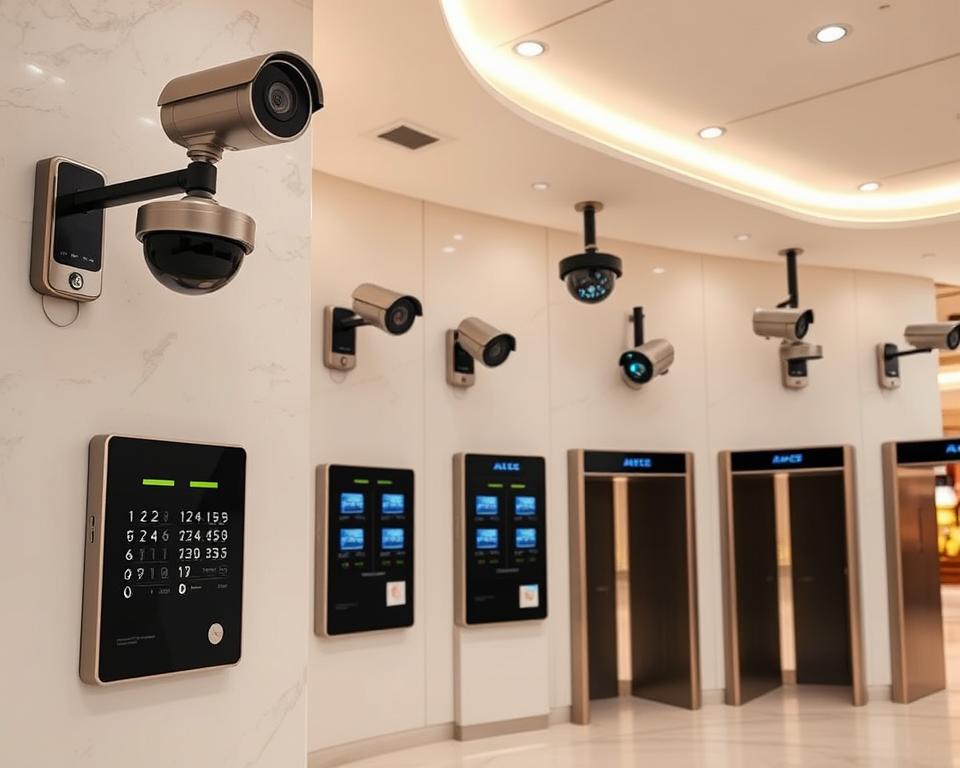Strengthen Your Project’s Construction Site Safety Immediately
Envision stepping onto your job site tomorrow and seeing critical gear stolen or perhaps equipment damaged. How quickly could delays of this kind derail deadlines and cost estimates? Projects frequently store expensive assets in open areas, making them prone to theft. Absent adequate protections, you are not merely putting at risk supplies—you’re jeopardizing all that your crew has constructed.
Thieves often go after sites with limited surveillance, mainly during off-hours. Stealing mobile equipment alone cost businesses companies millions each year. Setbacks due to replacing stolen gear or fixing vandalism bring stress and surprise bills. But here’s the good news: proactive event security guards planning could turn vulnerabilities into strengths.
Divine Protection Services excels at bespoke safety measures in dynamic environments. Its tactics integrate advanced technology plus practical expertise to keep your assets safe. In the sections that follow, you’ll discover concrete measures to deter theft, control access, as well as continue progress without compromises.
Ready to revamp your protection approach? Let us examine effective solutions designed to merge productivity and strong security.
Understanding the Basics of Construction Site Security
Annually, vulnerable construction sites experience millions of dollars in losses because of avoidable events. Unsecured zones housing valuable tools and machinery draw opportunistic thieves, chiefly at night. Let us break down the primary issues and why early action matters.

Where Weaknesses Hide
Unlocked storage containers, unattended materials, and poorly lit zones become easy prey. Recent industry reports show theft spikes by 40% during summer months when projects accelerate. Frequent security gaps are:
- Overnight portable generators
- Copper wire kept in sight
- Insufficient perimeter barriers
Expenses Exceeding Stolen Goods
One missing excavator could push project timelines back weeks as claims get processed. Vandalism repair bills often top $5,000 per event, rapidly draining budgets. Workers end up on overtime to compensate—doubling the productivity loss.
According to safety research, installing motion-sensitive lights cuts after-hours breaches by 60%. Pairing visible cameras with locked gates signals to intruders that risks outweigh rewards.
Addressing these basics first, you set up a robust groundwork for next-level measures. Next, we’ll explore tailoring solutions to your location’s unique needs.
Determining Your Site’s Specific Security Needs
What causes different sites to have different vulnerabilities? Every worksite has distinct features that shape its risks. A thorough evaluation of your property’s layout, workflow, and assets is the first step toward building defenses that actually work.
Locating Unique Risk Factors
get a layout of high-traffic zones and material storage points. Are expensive tools left near unlit corners? Is fencing incomplete near public roads? According to one safety guide, blind spots in high-traffic areas lead to 35% of thefts after hours. Fixing these issues promptly avoids future problems.
Consider how material storage affects vulnerability. Example: Copper wiring stored beside temporary entrances draws unwanted attention. Similarly, portable equipment left in open fields becomes an easy target. Tailored strategies might include:
- Configuring lights to operate during active hours
- Designating locked storage for high-value items
- Reconfiguring entry routes to minimize exposure
A bespoke safety strategy shields your workforce and assets. Proactive measures reduce delays and keep budgets intact. Addressing your site’s particular requirements crafts a security system that grows as the work progresses.
Putting Effective Security Measures in Place
A well-lit perimeter isn’t just about visibility—it’s your first defense against unwanted visitors. Here, we dive into tangible improvements marrying technology and clever layouts to safeguard your assets.
Lighting That Thinks Ahead
Lights triggered by motion wipe out hiding spots for unauthorized visitors. One site manager cut after-hours break-ins by 75% by placing these around storage zones. Combine them with:
- Solar-powered fixtures for remote zones
- Timed operations aligned with work schedules
- Weatherproof options for longevity
Multi-Functional Barrier Solutions
Solid fences do more than define edges—they impede trespassers. Case data indicates chain-link fences with anti-climb designs reduced trespassing by 60%. Choose materials that:
- Withstand impact from vehicles
- Allow visibility for patrols
- Have lockable entryways
Clear signage acts like a silent guard. “No Trespassing” warnings paired with alarm system decals make intruders think twice. A project saw thefts drop to zero after installing multi-language signs by access points.
Contemporary alarm setups deliver instant alerts to your mobile. Pair them with motion detectors and intelligent locks for multi-tiered defense. Schedule weekly checks with your crew to ensure all devices function properly—this small investment of time prevents big headaches later.
Adopting these tactics immediately fosters a more secure setting for staff and machinery. Ongoing revisions ensure your tactics remain strong as the job progresses.
Leveraging Technology for Job Site Security
No longer must you rely just on padlocks and security patrols. Today’s tools blend innovation with practicality, creating a safety net that works even when you’re off the clock. Let’s explore how smart tech solutions keep your assets protected without complicating workflows.
Ever-Vigilant Surveillance
Today’s cameras not only capture footage but also analyze it. Combining 4K video and motion sensors enables detection of suspicious actions, like loitering by storage bins after dark. A contractor saw an 82% drop in theft by employing setups that ping alerts to smartphones. Available types are:
- Solar-powered security units for distant areas
- All-weather camera models suited for extreme conditions
- IR-enabled cameras for crisp nocturnal footage
Recording nonstop catches every moment, and motion-based modes conserve power. “Combining both approaches cuts false alarms by 50%,” notes a recent tech report.
Intelligent Access, Smarter Management
Access badges simplify tracking without slowing down crews. Badge-scan entry records on-site presence—great for tracking subcontractor access. Advantages comprise:
- Immediate logging for review
- Remote permission updates
- Syncing with alarm systems
A PM noted, “We identified a delivery mistake quickly since our logs recorded who entered the equipment shed.” Security personnel remain essential, but technology covers routine inspections, letting them concentrate on critical zones.
These technologies enhance rather than substitute human decision-making. Uniting conventional techniques and modern tech crafts a defense that evolves alongside your project.
Optimizing Security with Divine Protection Services
How recently did your site’s safety strategy adjust to new threats? Divine Protection Services stands out by treating every location as unique. They kick off with detailed site assessments, tracking risks from material placement to regional crime data. This isn’t cookie-cutter protection—it’s precision.
Advantages of a Collaborative Security Method
Rather than off-the-shelf tactics, they examine your operations and site context. For instance, a highway project needed patrol adjustments according to local pedestrian patterns. Outcome: Six straight months without a theft. Their process involves:
- In-person reviews with safety engineering teams
- Bespoke tech integrations (aerial drones plus ground-based sensors)
- Monthly tactic adjustments to match project shifts
Skilled Security Staff and Guard Approaches
Their guards do more than patrol—they’re skilled in dispute handling and tech integration. A guard team averted $12k in losses by noticing odd behavior around fuel reserves. Their layered approach combines:
- Around-the-clock patrols on varied routines
- Real-time data feeds to mobile devices
- Quick-action emergency exercises
“We cut vandalism by 91% at affiliated sites,” says a senior official. Integrating human expertise and AI insights, they develop a proactive defense.
Methods to Stop Unauthorized Access and Theft
Consider intruders wandering onto your premises undetected. Open access points make job sites a magnet for opportunistic thieves. A single unlocked gate or poorly timed delivery can invite trouble—but smart planning stops intruders before they strike.
The Importance of Timing and Tracking
Arrange material arrivals during working hours to ensure supervision. A study reveals 68% of thefts take place during unmonitored overnight hours. Matching delivery times to staff schedules ensures immediate sign-off and secure storage
Restricting storage areas with secure access points lessens theft risk. Set aside locked lockers for valuable equipment with tamper-proof casings. As one project manager noted: “When everything has a designated spot, missing items stand out fast.”
- Limit access to primary gates after hours
- Implement RFID tagging for live equipment monitoring
- Conduct random audits during shifts
Skilled guards make a difference. Guards who patrol perimeters and check credentials deter trespassers effectively. Integrate guards with digital logging of visitor entry and exit times.
Minor tweaks—such as shifting delivery schedules or moving storage containers—form significant theft barriers. Assess protocols every week to seal vulnerabilities before they escalate. Marrying logistics and protection ensures projects remain on schedule and within budget.
Ensuring Site Safety Through Comprehensive Risk Mitigation
How will you respond if a storm inundates your storage area at 12 AM? While cameras and barriers provide the first line of defense, real security arises from readiness for the unforeseen. Merging insurance with emergency plans builds a net that propels projects forward even amid crises.
Insurance Paired with Practical Planning
Proper insurance coverage makes catastrophes manageable setbacks. A contractor sidestepped $78k in losses when thieves hit—insurance paid for replacements with no deadline impact. Yet, coverage alone isn’t sufficient. Match it with:
- Documented equipment inventories
- 24/7 response teams for security breaches
- Weather-responsive evacuation procedures
Review your plans each quarter. A Midwest crew avoided injuries during a tornado by rehearsing shelter protocols. Their drills cut evacuation time by 63% compared to neighboring job sites.
Contemporary alarm systems sync with emergency alerts. When sensors detect flooding or fire, they automatically alert local responders. These two functions assist in preventing unauthorized entry during emergencies.
Revise risk evaluations as the job progresses. Emerging stages could need extra insurance or updated evacuation paths. One safety officer advises: “Consider your emergency plan a living document—it improves with each trial.”
Merging financial protections and rehearsed actions secures both belongings and crews. Begin modestly: audit policies this week and plan your initial drill. Readiness now averts chaos later.
Tackling Typical Security Issues on Construction Sites
Securing a job site isn’t merely about installing cameras and fences—it involves daily collaboration and clever solutions. Staff changes, shifting schedules, and evolving layouts can strain even the best plans. A contractor confided: “We rotated through three security teams in a month—keeping consistent seemed unattainable.”
Handling Security Staff and Routine Procedures
Rapid staff changes hinder training and coordination. Concise checklists enable new personnel to grasp patrols and reporting swiftly. Example: Daily walkthroughs with photo records decreased unresolved problems by 45% on a Texas skyscraper site.
Using RFID tagging for equipment tracking cuts down losses. Use them alongside lockable storage zones for items such as power tools. Visible signage designating restricted zones further deters casual intruders. One Florida crew experienced a 30% decline in thefts by posting multi-language alerts near material stacks.
Time pressures often force rushed decisions. One fix: scheduled access logs for material deliveries and subs. This manages urgent timelines while keeping entry secure. Weekly checks on storage trailers and fuel tanks offer an added oversight layer without delaying tasks.
Sites shift quickly—yesterday’s staging area might be tomorrow’s foundation pour zone. Frequent team meetings make sure all staff understand updated protocols. As one manager noted: “When we review security tweaks during safety meetings, compliance improves naturally.” Small adjustments keep protection agile as the job evolves.
Sustaining Long-Term Security Through Best Practices
Consistency distinguishes short-term fixes from enduring security. View your security plan as a daily routine—tiny, deliberate steps lead to rock-solid outcomes. Regular checks and adaptive strategies keep your workspace secure through every project phase.
Establishing Accountability with Regularity
Routine daily inspections enable teams to identify problems before they worsen. A quick scan of the perimeter might reveal a damaged section of fencing or an alarm sensor needing calibration. One contractor found a breached storage container during their morning check, preventing $8k in losses.
Comprehensive logs form documentation that enhances accountability. Log weather factors, equipment conditions, and any atypical occurrences. “Digital logs helped us identify a pattern of after-hours deliveries that didn’t match schedules,” shared a safety manager from Arizona.
Blend tangible measures with smart tech for total coverage:
- Enhance fences using tamper-resistant connectors
- Test alarm systems weekly
- Use geofencing apps to monitor restricted zones
Monthly strategy reviews ensure your approach evolves with the project. When a Florida team expanded their workspace, they adjusted patrol routes to cover new access points—reducing blind spots by 70%. Kick off immediately: pair up for walkthroughs, make concise checklists, and mark successes. One expert noted: “Security is a marathon, not a sprint—each step matters.”
Combining Everything for a Safeguarded Construction Site
Your project’s outcome relies on more than plans and helmets—it needs multiple security layers that shift with changing threats. Combining physical barriers like sturdy fencing with smart alarm systems creates a shield that deters trespassers day and night. Consistent patrols with expert security guards offer human vigilance, and motion-triggered lighting annihilates shadowed areas where thieves hide.
Preventing unauthorized access starts with simple steps: lock high-value tools in designated storage zones, update access codes weekly, and install visible cameras near entry points. Studies show properties using these methods reduce theft and vandalism by 70% compared to unprotected areas.
Divine Protection Services specializes in developing customized solutions for variable sites. They unite sophisticated devices like IR sensors with proactive methods—random patrols, multilingual warnings, and instant breach notifications. One customer prevented $50k in losses when their system detected odd behavior at the perimeter.
Prepared to fortify your protection? Start now by evaluating vulnerabilities and booking a complimentary review. Through forward-thinking planning and professional assistance, you’ll erect more than buildings—you’ll achieve peace of mind.
Common Inquiries
What risks most frequently threaten job site safety?
Unauthorized entry, theft of tools or materials, and vandalism are top concerns. Exposed site designs, costly machinery, and distant locations frequently draw intruders. Bad weather and insufficient illumination can exacerbate vulnerabilities.
How do I block theft during off-hours?
Employ motion-activated lighting, strong perimeter fences, and obvious surveillance warnings. Lock away expensive items in secure containers. Partner with firms like Divine Protection Services for after-hours patrols and real-time alarm monitoring.
What security measures work best for temporary projects?
Portable anti-climb fencing, solar-powered cameras linked to cloud storage, and short-term access credentials for staff. Strategically placed motion sensors and daily equipment audits help maintain oversight in changing environments.
Is tech capable of replacing human guards?
Even though drones and advanced cameras improve oversight, skilled guards remain vital. Mixed approaches blending AI-driven analysis and on-site guards, such as verified security services, provide layered safety.
How to manage site access without hampering work?
Use RFID cards or biometric readers for quick checks. Define entry paths with visible signs and allocate distinct delivery zones. Plan deliveries in staffed hours to avoid leaving materials unsupervised.
Is theft of materials covered by insurance?
Major insurance plans demand evidence of adequate measures like alarms or manned checkpoints. Track all security actions, list gear with serial numbers, and promptly file reports with law enforcement.
How often should security protocols be updated?
Assess protocols weekly as the site changes. Upcoming project phases could call for altered camera placements, extra fencing, or revised access rosters. Perform random audits to verify that crews adhere to procedures uniformly.
Which everyday habits boost long-term safety?
Morning safety huddles to review risks, evening gear lock-up procedures, and end-of-day boundary checks. Utilize tools such as SafeSite for instant reporting and electronic logging of site events.
Do visible cameras suffice to keep out intruders?
While helpful, combine them with other deterrents. Display “24/7 Surveillance” notices, install gravel walkways to reveal footprints, and switch up guard patrol schedules. In critical areas, deploy visible camera casings with blinking lights along with covert backup cameras.


